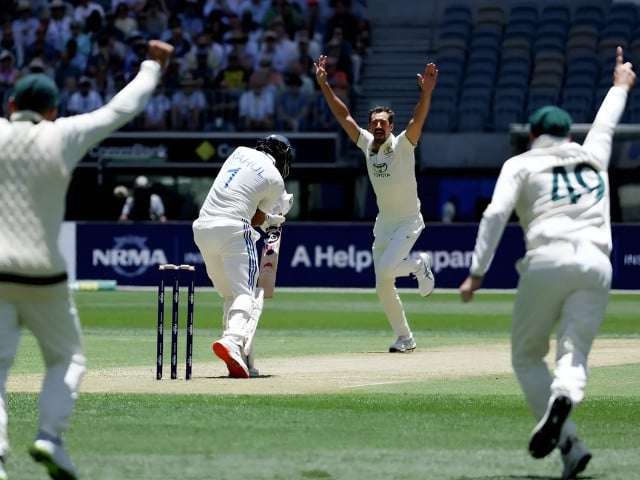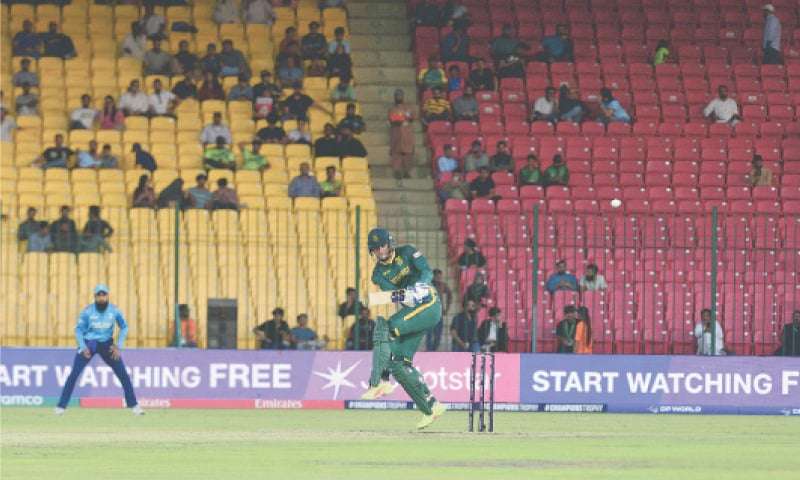Australia Defends Their Pink-Ball Legacy with a Stunning Performance
Australia made a strong statement on the first day of the second Test in Adelaide, as Mitchell Starc’s brilliant bowling performance spearheaded their efforts to dismiss India for a mere 180 runs. The day-night Test, known for its unpredictable nature with the pink ball, proved to be a challenge for the visitors, especially under the overcast conditions at the Adelaide Oval.
Rohit Sharma’s Decision to Bat First Backfires
India’s captain, Rohit Sharma, won the toss and elected to bat, hoping to take advantage of the dry conditions that promised a competitive pitch. However, the decision did not pay off, as Australia’s bowlers, led by Starc, capitalized on the early movement offered by the pink ball. With conditions favoring the seamers, India struggled to build any significant partnerships.
Starc Sets the Tone Early with a Stunning Opening Over
The match began in dramatic fashion when Mitchell Starc bowled the first ball of the match and removed Yashasvi Jaiswal for a duck. This early breakthrough put India on the back foot and set the tone for the rest of the day. It wasn’t just about the wickets, but the way Starc used the swing and seam to dismantle the Indian lineup, making it difficult for them to settle.
India’s Top Order Crumbles Under Pressure
The Indian batting line-up, which had shown immense resilience in their previous match against Australia, seemed unable to handle the pressure of the early session. The second session of the match saw India lose six crucial wickets. The dismissal of the captain Rohit Sharma for just three runs was a significant blow, followed by the aggressive Rishabh Pant who fell for a mere 21 runs.
Kohli and Gill’s Short Stay at the Crease
Virat Kohli, who had been expected to anchor the innings, fell cheaply for just 7 runs, caught by Steven Smith off Starc’s bowling. With the score at 77/3, Australia had their foot firmly on India’s neck. Shubman Gill showed some promise but was eventually dismissed lbw by Scott Boland for 31 runs off 51 balls. Gill had played confidently, including hitting five boundaries, but couldn’t last long enough to make a substantial contribution.
Pant’s Woes: Dropped and Then Dismissed
Rishabh Pant’s woes continued when he was dropped on five by Nathan McSweeney, but his luck didn’t last long. Pant was dismissed shortly after, edging a rising ball from Pat Cummins, which was caught by Marnus Labuschagne at second slip. The wicket signified Australia’s complete dominance of the match by that point.
Starc Shines Bright with a 6-Wicket Haul
Starc returned to the attack to wrap up India’s lower order with devastating precision. He claimed the crucial wickets of Ravichandran Ashwin (22) and Harshit Rana (0) in quick succession, leaving India reeling at 180 all out.
Australia’s Bowlers Run Riot
The Australian seamers, led by Starc, had been exceptional. Starc’s final figures of 6 wickets for 48 runs highlighted his dominance on the day. Pat Cummins and Scott Boland played their part as well, claiming two wickets each, ensuring that the visitors never got going.
India’s Early Struggles: A Setback Ahead of a Confident Second Test
Coming into the second Test with confidence from their dominant 295-run victory in the opening Test in Perth, India seemed poised to challenge Australia on their home turf. However, the performance at Adelaide Oval demonstrated the challenges of playing in day-night matches with the pink ball. Australia, on the other hand, maintained their exceptional record at this venue, having won all seven previous pink-ball Tests at Adelaide.
Rohit Sharma’s Optimism for the Adelaide Pitch
Rohit Sharma, who missed the first Test due to personal reasons, expressed optimism about the conditions ahead of the match. He described the pitch as being slightly dry with some grass cover, suggesting that it would offer something for both batsmen and bowlers alike. However, the Indian batting line-up was left floundering against Australia’s relentless attack.
India’s Squad Changes: Ashwin Returns to the Fold
India made one change to their squad by bringing in veteran off-spinner Ravichandran Ashwin, who replaced Washington Sundar. The inclusion of Ashwin added strength to India’s bowling attack, but it was their batting that fell short. Dhruv Jurel and Devdutt Padikkal were dropped from the squad, with no place found for them in the playing eleven.
Australia’s Adjustments: Boland Comes in for Hazlewood
On the Australian side, Scott Boland was introduced to the playing XI in place of the injured Josh Hazlewood. Despite the injury setback, Australia’s pace attack remained potent, with Boland contributing to the early breakthroughs along with Starc and Cummins.
Pat Cummins, the Australian captain, expressed that while the team would have preferred to bat first, they were ready to exploit the early conditions with the pink ball. The pacers were well-prepared for the conditions, knowing that the pink ball could behave differently than the red ball and offer more movement.
Teams:
Australia:
- Usman Khawaja
- Nathan McSweeney
- Marnus Labuschagne
- Steven Smith
- Travis Head
- Mitchell Marsh
- Alex Carey (wicketkeeper)
- Pat Cummins (captain)
- Mitchell Starc
- Nathan Lyon
- Scott Boland
India:
- Yashasvi Jaiswal
- KL Rahul
- Shubman Gill
- Virat Kohli
- Rishabh Pant (wicketkeeper)
- Rohit Sharma (captain)
- Nitish Kumar Reddy
- Ravichandran Ashwin
- Harshit Rana
- Jasprit Bumrah
- Mohammed Siraj
Conclusion: A Challenging Day for India
Australia’s dominant performance with the ball left India with little to cheer about on the opening day of the second Test in Adelaide. With Starc leading the charge and his teammates supporting him well, Australia took full advantage of the conditions, leaving India with plenty of work to do on the following days. The Indian batting line-up, though strong on paper, needs to regroup if they are to challenge Australia’s formidable bowling attack.
FAQs
1. How did Mitchell Starc perform on the opening day of the Adelaide Test?
Starc had an outstanding performance, taking 6 wickets for 48 runs, which played a significant role in dismissing India for just 180 runs on the first day.
2. Why did Rohit Sharma elect to bat first on the Adelaide pitch?
Rohit Sharma believed that the dry pitch, with a bit of grass covering, would offer a fair contest for both batsmen and bowlers, making it ideal to bat first.
3. What changes did India make to their squad for this match?
India brought in Ravichandran Ashwin in place of Washington Sundar, while Dhruv Jurel and Devdutt Padikkal were dropped from the squad.
4. How did Australia adjust to the conditions for this Test?
Australia made a strategic change by replacing the injured Josh Hazlewood with Scott Boland. They also capitalized on the pink ball conditions to gain early breakthroughs.
5. How did the pink ball behave in Adelaide?
The pink ball proved to be a challenge for the Indian batsmen as it offered movement under the overcast skies, with Australia exploiting the conditions expertly
ALSO READ:
https://flarenews.pk/2024/12/06/bushra-bibi-criticizes-pti-leaders-over-d-chowk-protest/



